#Mycenaean squid
Text
Cephalopod Spotting @ National Archaeological Museum, Athens

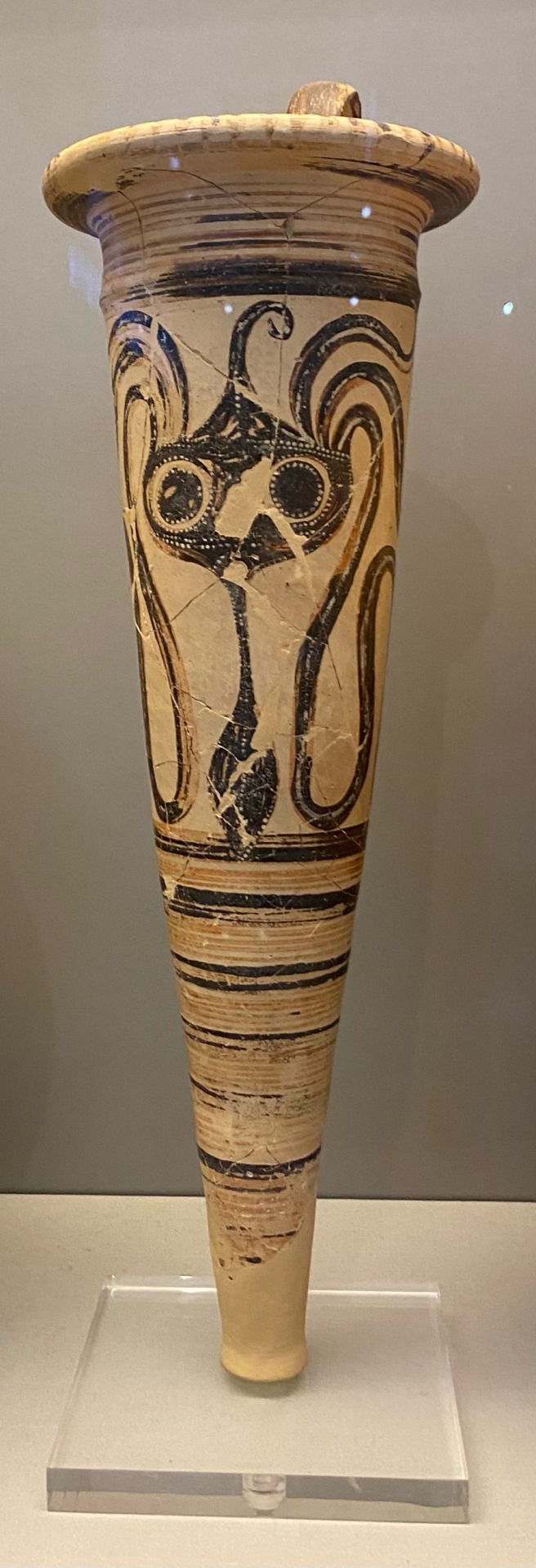
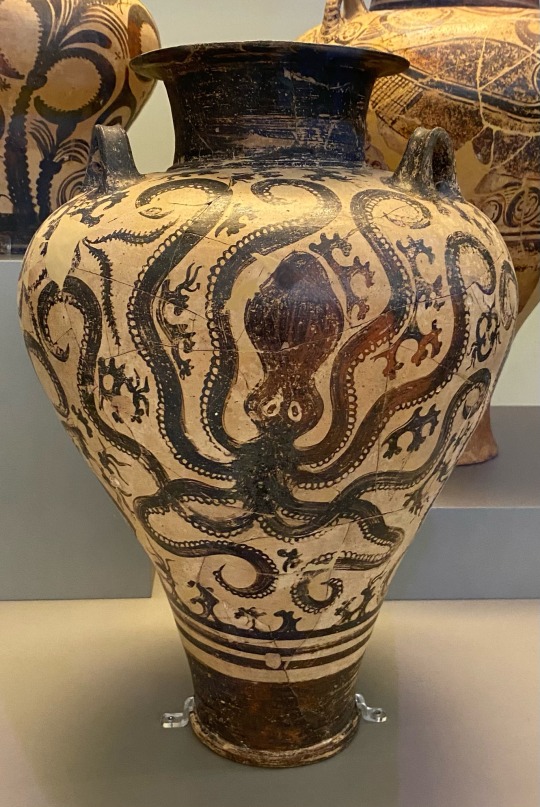

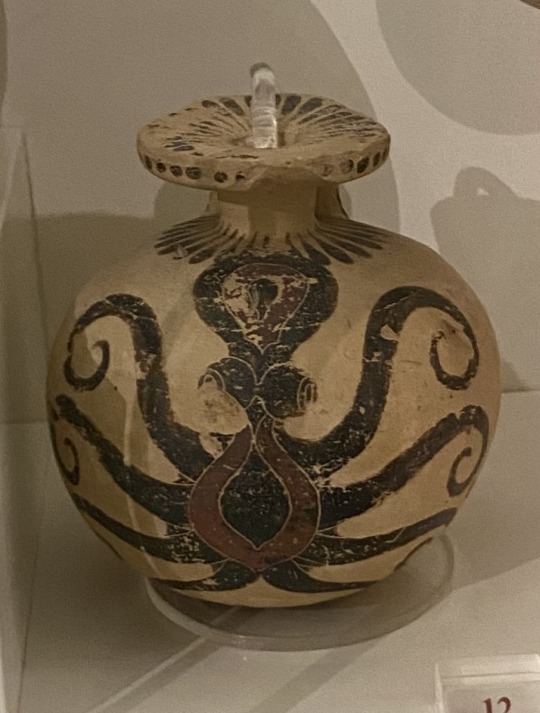
#Minoan squid#Mycenaean squid#squids#Ancient Greece#hellenic polytheism#hellenic paganism#athensposting#Minoan#tagamemnon
761 notes
·
View notes
Note
23. strange habits?
31. what outfit do you wear to kick ass and take names?
57. the three biggest struggles you’ve overcome? (besides hygiene issues)
93. nicknames? (I already know this one, its Stinky)
98. favorite historical era?
Strange habits? I suppose whenever I buy any clothes. I'll keep them in the packaging until I know I'm going to wear them. So I'll wash them beforehand of course but i think it's to make sure I wear that piece of clothing at least once ☝️
31. My all Jean jumpsuit babyyyyyy. I have full mobility to haul ass, to high kick and its durable enough to skid down small cliffs on my knees. I look hot as hell in it. It's sleeveless so it shows off my arms 💪💪💪
57. (HEY!!!!) Biggest struggles? God. Growing up with my family could cover 50. But that along with breaking up from a bad relationship (and THRIVING) and struggling to make enough money to enjoy life that I've just recently achieved would be my 3.
93. Nicknames. Bea's actually a nickname that got adopted. I'm also known as Bunny, Squid, Lea, Billy and my baby sister and I have called eachother beeboo since we were like 9/13 years old.
Favorite historical Era? I remember very distinctly loving the Mycenaean age of ancient Greece where a lot of statues we were studying in class were created. Lots of new inventions during that time too...if I'm remembering that correctly 🤷♀️
#ask#odeonagrecianbutt#oh thank christ you typed all of these out for me bless you sir#i have SO MANY GOOD ASS KICKING OUTFITS THOUGH#my wardrobe is bursting to the brim with clothing
2 notes
·
View notes
Note
Anything about cephalopods? Squids, octopi, those types?
The first and most important thing about octopuses is that they show up in the best movement in art history: Minoan Marine Style pottery. The first piece pictured below is from Crete circa 1500 BCE & it rules. The Mycenaeans clearly shared this (extremely correct) opinion, because they copied the style in their own pottery, like the second example from 1375-1300 BCE:

[Archaeological Museum of Heraklion, photo: Wolfgang Sauber, CC BY-SA 3.0]
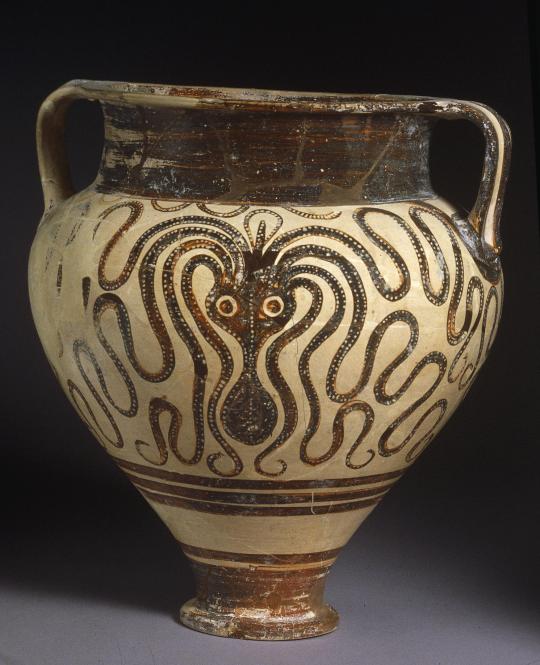
[ © The Trustees of the British Museum]
Naturalists, on the other hand, were not a fan of polyps (usually octopuses, but could extend to squid/kraken) & considered them deeply malicious:
“Terribly greedy and for ever plotting some evil” -Aelian
“There is not an animal in existence, that is more dangerous for its powers of destroying a human being when in the water. Embracing his body, it counteracts his struggles, and draws him under with its feelers and its numerous suckers, when, as often is the case, it happens to make an attack upon a shipwrecked mariner or a child. If, however, the animal is turned over, it loses all its power; for when it is thrown upon the back, the arms open of themselves.” - Pliny the Elder
The standout bestiary examples are from Der naturen bloeme, where they’re either delicately cradling victims:

[KB 76 E 4, fol. 69r]
or providing an entirely literal interpretation of “fish with arms”:

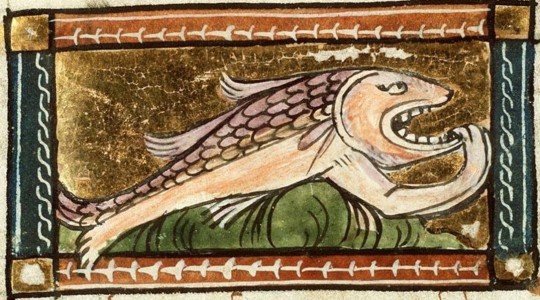
[KB 76 E 4, fol. 75v; KB KA 16, fol.116v]
#asks#octopus#squid#sea monsters#if you have a minute I seriously recommend googling Minoan pottery#it slaps
657 notes
·
View notes
Photo

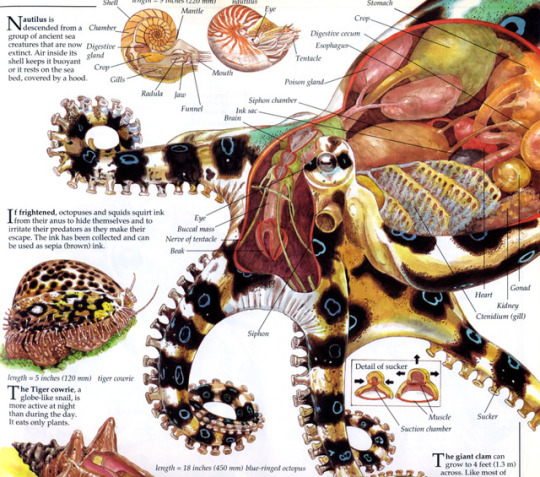
“The Alien Octopus Hypothesis”
In April, 2018, the journal Progress in Biophysics and Molecular Biology published a remarkable scientific paper:
Cause of the Cambrian Explosion – Terrestrial or Cosmic?
33 authors from reputable universities and research institutes, make an incredible point that life did not originate on the planet Earth.
Cephalopods (the group comprising squid, cuttlefish, nautilus and octopus) have a somewhat confusing evolutionary tree, “are an island of mental complexity in the sea of invertebrate animals”
Octopus is the most striking, with features, such as a complex nervous system, sophisticated eyes, the capacity of editing its own DNA (not to mention its 9 brains and 3 hearts), that appear quite suddenly in its evolution (there is evidence of extensive changes in its RNA).
The genes necessary for this transformation, the authors suggest, are not present in its ancestry (the nautilus). Thus, they hold that “it is plausible then to suggest they seem to be borrowed from a far distant ‘future’ in terms of terrestrial evolution, or more realistically from the cosmos at large.”
The paper argues the space-based transfer of life was likely on a larger scale than just retroviruses (proven aliens already).
“One plausible explanation,’ the researchers argue, “in our view, is that the new genes are likely new extraterrestrial imports to Earth – most plausibly as an already coherent group of functioning genes within (say) cryopreserved and matrix protected fertilized octopus eggs.” This would “be a parsimonious cosmic explanation for the octopus’ sudden emergence on Earth [about] 270 million years ago.”
“Nature is incredible, and I do not think it is necessary to call on extraterrestrials to explain” says astrobiologist Frances Westall, being skeptical of the paper...
The Daily Galaxy via US Marine Biological Laboratory and CfA
images:
Terracotta stirrup jar with octopus, ca. 1200–1100 B.C. Helladic, Mycenaean; Late Helladic IIIC; H. 10 1/4 in. (26 cm)
Internal anatomy of a blue-ringed octopus, scanned from The X-Ray Picture Book of Amazing Animals by Gerald Legg. Art by Carolyn Scrace
9 notes
·
View notes
Text
Cooking The Mediterranean-Island Countries | jovin...
New Post has been published on https://cucinacarmela.com/cooking-the-mediterranean-island-countries-jovin/
Cooking The Mediterranean-Island Countries | jovin...
amzn_assoc_placement = "adunit0"; amzn_assoc_tracking_id = "carmela-20"; amzn_assoc_ad_mode = "search"; amzn_assoc_ad_type = "smart"; amzn_assoc_marketplace = "amazon"; amzn_assoc_region = "US"; amzn_assoc_title = "Shop Related Products"; amzn_assoc_default_search_phrase = "cooking"; amzn_assoc_default_category = "Kitchen"; amzn_assoc_linkid = "51fe4d035c7af8dc5928e6f5e5b79c4e"; amzn_assoc_default_browse_node = "284507"; amzn_assoc_rows = "4"; amzn_assoc_design = "text_links";
Malta
Cyprus
The Mediterranean countries include France, Spain, Italy, Greece and Portugal along the north; Turkey, Syria, Lebanon, and Israel on the east; the African countries of Egypt, Libya, Tunisia, Algeria and Morocco on the south and the Mediterranean Island Countries of Cyprus and Malta. The Mediterranean countries utilize many of the same healthy ingredients but each country has a unique way of creating recipes with those same ingredients. So far in this series, I have written about Mediterranean cuisine in general and about the cuisine in the countries of Portugal, Spain, France, Italy, Greece, Turkey, Syria, Lebanon, Israel, Egypt, Libya, Tunisia, Algeria, and Morocco. This series concludes with the Mediterranean Island Countries (also referred to as the Mediterranean States) of Cyprus and Malta.
There are only two Island countries in the Mediterranean Sea.
Malta, officially the Republic of Malta, consists of the main island of Malta and the smaller islands of Gozo and Comino. The island nation is located east of Tunisia, and about 100 km (60 mi) south of the island of Sicily, Italy.
Malta has been inhabited since 5900 BC. Its location in the center of the Mediterranean has historically given it great strategic importance as a naval base, with a succession of powers having ruled the island, including the Phoenicians, Carthaginians, Greeks, Romans, Byzantines, Arabs, Normans, Sicilians, Spanish, Turks, French, and British. Most of these foreign influences have left a mark on the country’s ancient culture. The official languages are Maltese and English, with Maltese also recognized as the national language. Italian is also spoken by most of the population.
Cyprus is located south of Turkey, west of Syria and Lebanon, northwest of Israel, north of Egypt, and southeast of Greece. Cyprus was settled by Mycenaean Greeks in the 2nd millennium BC. As a strategic location in the Middle East, it was subsequently occupied by several major powers, including the empires of the Assyrians, Egyptians, and Persians.
Cyprus was placed under British administration in 1878 and was formally annexed by Britain in 1914. Currently, the Republic of Cyprus is partitioned into two main parts: the area under the control of the Republic, located in the south and west that comprises about 59% of the island’s area; and the north, administered by the self-declared Turkish Republic of Northern Cyprus, covering about 36% of the island’s area. Another 4% of the island’s area is the UN buffer zone.
Cuisine
Malta
Maltese cuisine shows strong Sicilian and English influences as well as influences of Spanish, Maghrebin and Provençal cuisines. A number of regional variations can be noted as well as seasonal variations associated with the availability of produce and Christian feasts (such as Lent, Easter, and Christmas). Food has been important historically in the development of a national identity and, in particular, the traditional fenkata (stewed or fried rabbit).
Traditional Maltese food is rustic and based on the seasons. On most food shop counters, you’ll see Bigilla, a thick pate of broad beans with garlic. Snacks include a round of bread dipped in olive oil, rubbed with ripe tomatoes and filled with a mix of tuna, onion, garlic, tomatoes, and capers. Also popular are pastizzi (flaky pastry filled with ricotta or mushy peas). Depending on the season, you’ll see spnotta (bass), dott (stone fish), cerna (grouper), dentici (dentex), sargu (white bream) and trill( red mullet) in the spring. Swordfish and tuna follow later, around early to late autumn, followed by the famed lampuka, or dolphin fish. Octopus and squid are very often used to make rich stews and pasta sauces.
The popularity of pork and its presence in various dishes can be attributed to Malta being on the edge of the Christian world. Consuming food which is taboo in the Muslim culinary culture could have been a way of self-identification by distinguishing oneself from the other. In addition to pork dishes, the cuisine includes Maltese sausages, kawlata (a vegetable soup) and baked rice.
Despite Malta’s small size, there are some regional variations. This is especially the case in the area of Gozo. Gozitan cheeselet and ftira Għawdxija, a flatbread topped or filled with potatoes or eggs, grated cheese, tomatoes, anchovies, olives, ricotta and Maltese sausage as other possible ingredients. Gozitan cheeselets are used as filling for ravioli instead of the usual ricotta.
Because Catholic fasting during Lent involved mostly meats and dairy products, fish such as Lampuki became a popular dish during this period as were stewed snails, stuffed artichokes, and fritters.
Cyprus
Cypriot cuisine is closely related to Greek and Turkish cuisine; it has also been influenced by Byzantine, French, Italian, Catalan, Ottoman and Middle Eastern cuisines.
Meze is a large selection of dishes with small helpings of varied foods, brought to the table as different courses. The meal begins with black and green olives, tahini, skordalia (potato and garlic dip), hummus, taramasalata (fish roe dip), and tzatziki, all served with chunks of fresh bread and a bowl of mixed salad.
Some of the more unusual meze dishes include octopus in red wine, snails in tomato sauce, brains with pickled capers, samarella (salted dried meat), quails, pickled quail eggs, tongue, kappari pickles (capers), and moungra (pickled cauliflower). Bunches of greens, some raw, some dressed with lemon juice and salt, are basic on the meze table. Fish, grilled halloumi cheese, lountza (smoked pork tenderloin), keftedes (minced meatballs), sheftalia (pork rissoles), and loukaniko (pork sausages) can follow. Hot grilled meats – kebabs, lamb chops, chicken – may be served toward the end. The dessert is usually fresh fruit or glyka – traditional sugar-preserved fruits and nuts.
Halloumi cheese originated in Cyprus and was initially made during the Medieval Byzantine period. Halloumi (Hellim) is commonly served sliced, either fresh or grilled, as an appetizer.
Seafood and fish dishes include squid, octopus, red mullet, and sea bass. Cucumber and tomato are used widely in salads. Common vegetable preparations include potatoes in olive oil and parsley, pickled cauliflower and beets, asparagus and taro. Other traditional delicacies are meat marinated in dried coriander seeds and wine, dried and smoked lountza (smoked pork loin), charcoal-grilled lamb, souvlaki (pork and chicken cooked over charcoal), and sheftalia (minced meat skewers). Pourgouri (bulgur, cracked wheat) is the traditional source of carbohydrate other than bread.
Fresh vegetables and fruits are common ingredients. Frequently used vegetables include courgettes, green peppers, okra, green beans, artichokes, carrots, tomatoes, cucumbers, lettuce and grape leaves, beans, broad beans, peas, black-eyed beans, chickpeas, and lentils. The most common fruits and nuts are pears, apples, grapes, oranges, mandarins, nectarines, medlar, blackberries, cherry, strawberries, figs, watermelon, melon, avocado, lemon, pistachio, almond, chestnut, walnut, and hazelnut.
Spices play an important role in the cuisine. The best-known spices and herbs include pepper, parsley, arugula, celery, fresh coriander (cilantro), thyme, and oregano. Traditionally, cumin and coriander seeds make up the main cooking aromas of the island. Mint is a very important herb in Cyprus. It grows abundantly, and locals use it for everything, particularly in dishes containing ground meat. For example, the Cypriot version of pastitsio contains very little tomato and generous amounts of mint. The same is true of keftedes (meatballs). Fresh coriander or cilantro are often used in salads, olive breads, spinach pies (spanakopita) and other pastries.
Cyprus is also well known for its desserts, including lokum (also known as Turkish Delight) and Soutzoukos. Loukoumades (fried dough balls in syrup), loukoum, ravani, tulumba, and baklava are well-known local desserts. There are also pastiș, cookies made of ground almonds, that are offered to guests at weddings.
Flaounes are savory Easter pastries that contain goat cheese (or a variety of cheeses), eggs, spices and herbs all wrapped in a yeast pastry, then brushed with egg yolk and dipped into sesame seeds.
Sources: https://www.visitmalta.com and https://www.cyprusisland.net/cyprus-cuisine
Maltese Rabbit Stew
Ingredients
1 rabbit, cut into 8 pieces
Sea salt and freshly ground pepper, to taste
Plain flour, for dusting
100 ml vegetable oil
3 onions, finely diced
1 head garlic, cloves peeled and thinly sliced
280 g tomato paste
2 tbsp curry powder
1 tbsp ground turmeric
1 tbsp paprika
1 tbsp ground cumin
1.5 liters of chicken stock
4 potatoes, peeled cut into 2cm dice
300 g peas
1 cup parsley leaves
Marinade
100 ml olive oil
1 head garlic, peeled
350 ml red wine
5 bay leaves
3 cinnamon sticks
4-star anise
3 whole cloves
Directions
To make the marinade, combine all the ingredients in a non-metallic bowl. Add the rabbit pieces, combine well, then cover and refrigerate for at least 2 hours.
Drain the rabbit pieces, reserving the marinade. Pat the rabbit dry, season to taste and dust with flour. Heat the vegetable oil in a large heavy-based saucepan over medium-high heat. Add the rabbit and cook until golden on both sides. Remove from the pan and set aside. Reduce the heat to medium, then add the onion and garlic and cook for 5 minutes or until softened. Add the tomato paste and spices and stir for a few minutes or until fragrant.
Add the reserved marinade and simmer for 15 minutes. Return the rabbit pieces to the pan. Add the stock and simmer for 20 minutes or until reduced by one-third. Cover with a lid, reduce the heat to low and cook for another 40 minutes. Add the potatoes and cook for another 30 minutes or until tender. A few minutes before serving, stir in the peas. Scatter with parsley and serve.
Maltese Baked Rice
Ingredients
2½ cups long grain rice
500g beef or pork mince (or a combination of the two)
1 onion diced
2 cloves garlic diced
2 tablespoons tomato paste
1 tablespoon curry powder
1 courgette diced
1 can chopped tomatoes
1 350 gram jar passata
1½ cups water
1½ cups grated cheddar cheese (1/2 cup is to be left aside to place on top of the dish before baking)
½ cup grated parmesan cheese
4 eggs lightly beaten
Olive oil for frying
Directions
Parboil rice by filling a medium pot with water ¾ of the way and boil. Add rice and reduce water to simmer for 15 minutes.
Drain rice and set aside.
Fry 1 tablespoon olive oil in a large frying pan and add mince. Fry for 5 minutes and then add tomato paste and curry powder. Fry for a further five minutes or until meat is browned. Remove fried meat and set aside.
In the same pan add 1 tablespoon olive oil and fry onion and garlic on medium heat for five minutes.
Add the courgette and fry for a further five minutes.
Add back the meat and add the chopped tomatoes, and passata.
Bring to a boil and then reduce to a simmer. Simmer for fifteen minutes.
Once completed; preheat oven to 220 C.
Add rice, cheese (leave some cheddar cheese aside to place on top) and eggs to the meat and tomato sauce mixture.
Add the mixture in a medium-sized baking dish plus the 1½ cups water too.
Place the remaining ½ cup of cheddar on top.
Reduce the oven to 180 C and place the dish in the oven.
Cook for 30 minutes or until crispy around the edges.
Cyprus Octopus with Oregano
Ingredients:
1 kg octopus
½ tsp dry oregano
Black Pepper
3 tbsp olive oil
2 tbsp vinegar or lemon juice
Directions
Clean the octopus thoroughly under cold running water.
Place the octopus in a pot with hot olive oil (1 tablespoon), cover and cook.
Simmer to bring out all the juices and continue cooking until the liquid is reduced and the octopus is tender. Add some water if needed.
Remove from the heat and drain.
Serve hot or cold, seasoned with oregano and olive oil/vinegar dressing or olive oil/lemon juice dressing.
Note: You can also cook the octopus on the grill. If the octopus is thick, cut it into small pieces before serving.
Cyprus Warm Halloumi and Peach Salad
Ingredients
3 ripe but firm peaches, halved and stoned
250g Halloumi cheese
2 tbsp olive oil
3 red chicory, root intact, quartered lengthwise
1 bunch spring onions, trimmed, cut into 2cm lengths
For the dressing
1 red chili, deseeded, finely chopped
½ large bunch fresh coriander, leaves and stalks roughly chopped
5 tbsp white wine vinegar
3 tbsp clear honey
Directions
Make the dressing by mixing everything together in a small bowl. Cover and set aside.
Cut each peach half into wedges.
Cut Halloumi into 1cm thick slices.
Heat half the oil in a large frying pan. Fry the cheese for 3-4 minutes on each side or until golden brown and almost crusty. Remove from the pan and keep warm.
Add the chicory and onions to the hot pan, stir-fry until slightly wilted and colored. Transfer onto an absorbent kitchen towel.
Heat the remaining oil. Add the peach wedges and fry for a minute or two, until softened, lightly colored but still retaining their shape.
Combine all the ingredients together then pour on the dressing.
Spoon onto individual plates.
Like this:
Like Loading…
Related
Posted by Jovina Coughlin in Desserts, Fish, Fruit, Herbs, Malta & Cyprus, Mediterranean Countries, peaches, Rabbit, Rice, Vegetables Tags: Mediterranean cooking, Mediterranean Island Countries
amzn_assoc_placement = "adunit0"; amzn_assoc_search_bar = "true"; amzn_assoc_search_bar_position = "bottom"; amzn_assoc_tracking_id = "carmela-20"; amzn_assoc_ad_mode = "search"; amzn_assoc_ad_type = "smart"; amzn_assoc_marketplace = "amazon"; amzn_assoc_region = "US"; amzn_assoc_title = "Shop Related Products"; amzn_assoc_default_search_phrase = "cookware"; amzn_assoc_default_category = "All"; amzn_assoc_linkid = "b45319dac495d29e17b5eff312392025";
Source link
0 notes
Text
Giant Squid, "Mycenaeans"
progmetal
http://oneironaught.com/giant-squid-mycenaeans/
0 notes